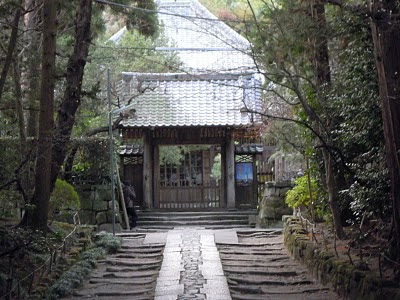 Here is a guide book of Kamakura written by a woman named Iso Mutsu(1867-1930). I was recommended to read this book by my adviser Johnny Buckle. Her precise depiction on Kamakura's temples and shrines is useful for me as a sightseeing tour guide in Kanakura.
Here is a guide book of Kamakura written by a woman named Iso Mutsu(1867-1930). I was recommended to read this book by my adviser Johnny Buckle. Her precise depiction on Kamakura's temples and shrines is useful for me as a sightseeing tour guide in Kanakura.
 Do you know anything about the author Iso Mutsu? If you are a Japanese, you may imagine this author was a member of Mutsu family.
Do you know anything about the author Iso Mutsu? If you are a Japanese, you may imagine this author was a member of Mutsu family.
Yes, she was. Then, why could she write such a detailed guide book of Kamakura in English? Was she a returnee from the USA or the UK?
No, she wasn't. She was a native speaker of English.
She got married to a son of Munemitsu Mutsu who was then the minister of foreign affairs. The son Hirokichi, while studying at Cambridge, fell in love with the landlord's daughter, Gertrude Ethel Passingham. There were many obstacles to their marriage, but they overcame the difficulties and finally got married in 1905. In 1910 she came to Japan for the second time and lived in Kamakura until her death.
In 1918 she wrote the classic guide 'Kamakura:Fact and Legend'.
She liked Japan and successfully apapted to this country, even giving English lessons to the members of the Imperial Family, among them Prince Chichibu, a brother of Showa Emperor.
After her death she was buried in the Mutsu family's yagura(cave-grave) in the Jufuku-ji Temple's graveyard.
 Jufuku-ji Temple
Jufuku-ji Temple
 Mutsu family's yagura(cave-grave)
Mutsu family's yagura(cave-grave)


 The Goddess of Mercy, Yugyo-kannon stands in the precinct of Kosho-ji Temple
The Goddess of Mercy, Yugyo-kannon stands in the precinct of Kosho-ji Temple



 The Goddess of Mercy, Yugyo-kannon stands in the precinct of Kosho-ji Temple
The Goddess of Mercy, Yugyo-kannon stands in the precinct of Kosho-ji Temple

















 Kagetoki Kajiwara's grave is at a strange site. Get off an Ofuna monorail train at Shonan-Fukazawa station. Within five minutes' walk you will arrive at Fukazawa Elementary School. Ask a security guard to open the gate and you will know where it is if you ask him politely. It is at the back of a school building.
Kagetoki Kajiwara's grave is at a strange site. Get off an Ofuna monorail train at Shonan-Fukazawa station. Within five minutes' walk you will arrive at Fukazawa Elementary School. Ask a security guard to open the gate and you will know where it is if you ask him politely. It is at the back of a school building.




 Before the ceremony I enjoyed watching kappore dance in the precinct of the temple. Dancers, men and women in their fifties or more, were dancing happily with the music of shamisen players.
Before the ceremony I enjoyed watching kappore dance in the precinct of the temple. Dancers, men and women in their fifties or more, were dancing happily with the music of shamisen players. 
